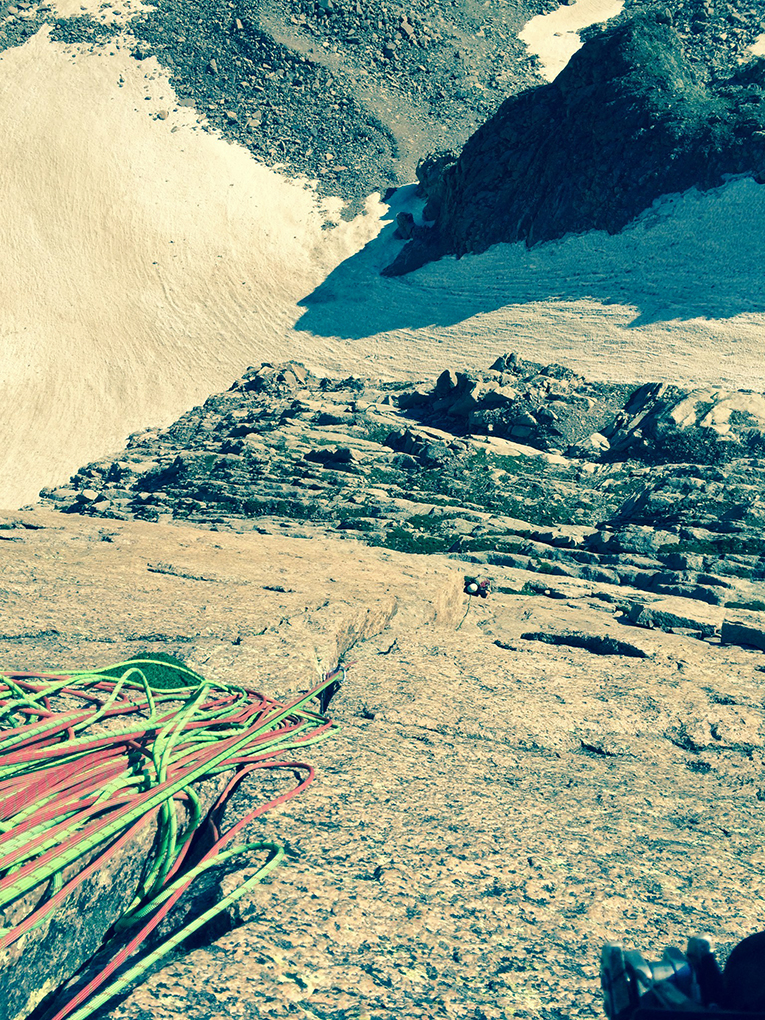Durability
Relative to other cutting-edge twin ropes, the Mammut Twilight ropes I’ve used have held up well. I’ve used them at Lumpy Ridge and Eldorado most extensively, though they did get some time ice climbing, as well as time on a few high alpine routes on the Diamond and elsewhere in Rocky Mountain National Park.
The pair is in good shape considering this abuse, but they’re showing a bit more wear than the Sterling Duettos I’ve used in the past. Admittedly, this is sort of an unfair comparison considering the diameter difference between the two ropes; I only want to make the point that the heavier twin/half options do still have an edge in some situations—durability (particularly in half rope mode) being chief among them.

If you’re looking at twins to move fast over alpine terrain (but aren’t comfortable with a static tag line), then the Twilight is an awesome rope, and I’d recommend it without reservation.
Other Considerations
The Twilight has a very smooth handle, and hasn’t given me inordinate trouble with kinking. That smooth handle is partly due to the construction of the rope, and partly due to the fact that when you get down to 7.5mm, any rope will move extremely fast through your belay device. Revisiting the earlier observation about reduced surface area contact for thinner ropes, a 7.5mm rope just doesn’t generate as much friction through a belay device as a thicker rope. When feeding out rope to belay, this means the rope floats almost effortlessly through the device.
That same effortlessness, however, threatens to run away from you when you’re on rappel. Especially if you’re loaded down with gear, vertical raps on these ropes with a pack is more of a workout than anyone should be expected to endure during a descent. I’m an advocate of all rappels being backed up with the hitch of your choice, but I think this point should be underscored in the case of the Twilights: it takes work to rap slowly on these lines. To a large extent, this is going to be true of any rope with a 7.5mm diameter, but since it can be a significant part of the experience of using a set of Twilights, it is certainly worth noting.
In a similar vein, belaying with an ATC-guide in guide mode (or a Reverso, or any other similar device) has the potential to introduce similar problems. The Twilight is thin enough that instead of two strands stacking reliably on top of one another to cause the auto-lock, the 7.5mm strands can work their way next to one another. This should still hold, but it’s disconcerting and it’s really not ideal. Granted, I still use them this way on occasion, but it’s worth noting that you should be particularly attentive to the ropes if you’re going to do so, as this isn’t something you’ve likely encountered if you’re used to single ropes, or even 8mm+ half/twins.
Bottom Line
The 7.5mm Mammut Twilight is a fantastic example of the modern twin/half ropes that offer great weight savings, and are among the most effective tools available to alpine climbers, comparable even to a single rope with a tag line. The Twilight’s durability does suffer slightly as a result of the extremely thin diameter, so climbers looking for lots of half-rope functionality might get more bang for their buck from an 8mm+ set.
